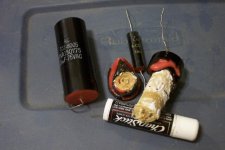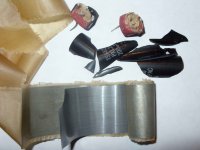Hey Guys,
I was just wondering if anyone would recognize this capacitor. It's at least as old as the early 1980's (~30years old),and I'm just wondering if it's still good (film,etc.),or if I should order up some new ones.
Here's a picture
http://i199.photobucket.com/albums/aa154/Nothing40/PICT00012.jpg
It says:
NP
TSI-7714
PXA20NV30
20uF-30VNP
To me it seems to be some kind of non-electrolytic (film?) cap,with sealed ends.
I'm off to Google it a bit more..
I was just wondering if anyone would recognize this capacitor. It's at least as old as the early 1980's (~30years old),and I'm just wondering if it's still good (film,etc.),or if I should order up some new ones.
Here's a picture
http://i199.photobucket.com/albums/aa154/Nothing40/PICT00012.jpg
It says:
NP
TSI-7714
PXA20NV30
20uF-30VNP
To me it seems to be some kind of non-electrolytic (film?) cap,with sealed ends.
I'm off to Google it a bit more..
Yeah, film with plastic (polypro, polyester, PS) dielectric would be my guess as well. 20 uF, 30 V. Unless it's shorted, it's probably still good.
~Tom
~Tom
Yea,it's a 20uF Bipolar from a crossover network. I'll see what kinda testing I can do on it,and see if it's still any good. Something with a voltage rating higher than 30 volts might be good too.
Yea,DIY jobbies made in about 1983 or so. 🙂
They seem to be in good shape,so I guess I'll reuse them for now. I might want to find some with a higher voltage rating later on.
They seem to be in good shape,so I guess I'll reuse them for now. I might want to find some with a higher voltage rating later on.
FIVE 30UF 30V 5% Metallized Polyester Capacitors - eBay (item 260713484492 end time Jan-04-11 08:34:33 PST)
(looks like an Altec Lansing part from 2nd part '70s, 1st half '80s))
(looks like an Altec Lansing part from 2nd part '70s, 1st half '80s))
Last edited:
(looks like an Altec Lansing part from 2nd part '70s, 1st half '80s))
I was thinking the same thing,I've seen very similar looking caps in some old Altec car speakers. (they were built like tanks!)
Non-polar electrolytic.
Manufactured by TSI in 12th week of 1977.
Here are several similar caps in a crossover from a Triad mini-system from the mid-eighties. Note the date code: 8210 (10th week 1982)
The 200uf cap is 2.1" x 0.7". Way, way, way too small to be anything but electrolytic.
Manufactured by TSI in 12th week of 1977.
Here are several similar caps in a crossover from a Triad mini-system from the mid-eighties. Note the date code: 8210 (10th week 1982)
The 200uf cap is 2.1" x 0.7". Way, way, way too small to be anything but electrolytic.
Attachments
Last edited:
Mea culpa, more likely neither film nor electrolytic (imo).
They're small/large enough to be paper in oil caps.
These and Callin PIO caps were used in Altec '70s/'80s models ; Nineteen, Santiago, Santana II, Valencia, etc.
Example picture (scuse the non bipolar part)=>
They're small/large enough to be paper in oil caps.
These and Callin PIO caps were used in Altec '70s/'80s models ; Nineteen, Santiago, Santana II, Valencia, etc.
Example picture (scuse the non bipolar part)=>
Attachments
Last edited:
Non-polar electrolytic.
Manufactured by TSI in 12th week of 1977.
Here are several similar caps in a crossover from a Triad mini-system from the mid-eighties. Note the date code: 8210 (10th week 1982)
The 200uf cap is 2.1" x 0.7". Way, way, way too small to be anything but electrolytic.
It are bipolar electrolytics giving typical "English" sound.
😎
If you replace these by plastic film caps you get a totally different sound.
Last edited:
I think Jacco gets the prize on this one.😱
Having never (until about ten minutes ago) cut one open, I would not have believed a PIO cap could have the volumetric efficiency to pack 200uf in so small a package. However, given the low voltage rating, it appears that it is indeed possible.
Interestingly, the 2mil (0.06mm!) foil electrodes appear to be something other than aluminum. Tin perhaps? One thing is certain: they do not melt or oxidize when heated to almost white heat with a torch. Definitely not aluminum.
In any event, I think most of us would agree that these capacitors would best be replaced with ones using a more modern dielectric.
Having never (until about ten minutes ago) cut one open, I would not have believed a PIO cap could have the volumetric efficiency to pack 200uf in so small a package. However, given the low voltage rating, it appears that it is indeed possible.
Interestingly, the 2mil (0.06mm!) foil electrodes appear to be something other than aluminum. Tin perhaps? One thing is certain: they do not melt or oxidize when heated to almost white heat with a torch. Definitely not aluminum.
In any event, I think most of us would agree that these capacitors would best be replaced with ones using a more modern dielectric.
Attachments
In any event, I think most of us would agree that these capacitors would best be replaced with ones using a more modern dielectric.
This will dramatically alter the voicing of the speaker. Maybe even for the better.
I am also surprised by the contents of the cap. Many thanks to you and Jacco.
Huh,interesting. Thanks for the investigation guys! I guess I'll order up some new caps and call it good.
- Status
- Not open for further replies.
- Home
- Design & Build
- Parts
- Can anyone ID this cap?


